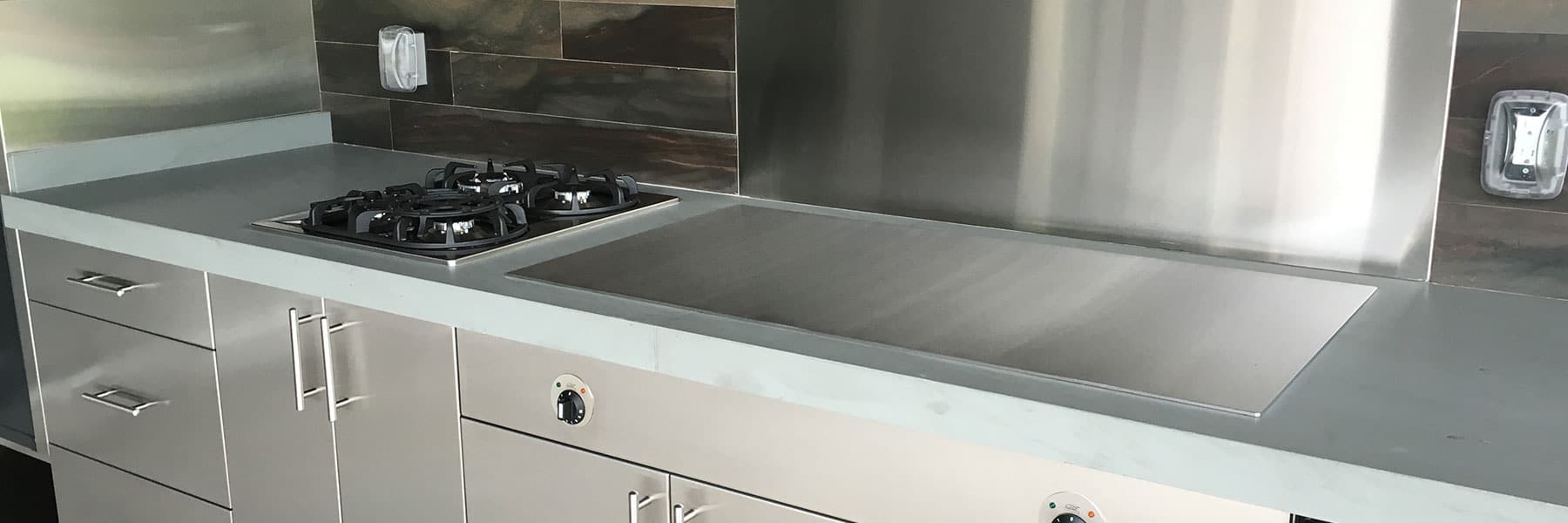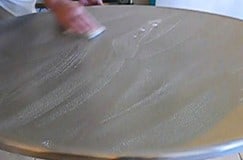Stainless steel, thanks to its remarkable durability and corrosion resistance — not to mention the sleek, smooth finish — has earned quite the reputation in manufacturing industries, grilling included. This desirable material is a sign of solid quality among BBQ grills, and high-grade 304 stainless steel is a calling card of premium BBQ’s, grills & teppanyakis. But as is the case with any other material, time and use can cause stainless steel to scratch, rust, collect grime, and, yes, even stain.
The key to preserving its shine and strength? Proper maintenance and cleaning.
Stainless Steel is Easy to Clean
Cleaning & maintaining stainless steel grills is incredibly easy! Fingerprints, grease splatters, scratches, discoloration, and even surface rust can be tackled with diligence and a little bit of know-how. The “diligence” bit is up to you — and we will share some know-how so you can maintain your teppanyaki BBQ grill in pristine condition.
What is Stainless Steel?
The chemical composition of stainless steel has a huge influence on its properties, as well as best practices for cleaning and maintenance. No, we’re not asking you to dust off your high-school chemistry knowledge just bear with us while we get through the technical talk.
In short, stainless steel is an alloy containing at least 10.5% chromium, less than 1.2% carbon, and a variety of other elements that alter the mechanical and corrosion-resistant properties of the resulting metals. The American Iron and Steel Institute has assigned a 3-digit code (eg 304 or 316) to each of these varying alloys for easy identification. For instance, the nickel present in 304-grade stainless steel makes it extra tough against rust, while the lesser 430 and 443 grades lack that chemical. There’s also 316L, marine-grade stainless steel that features molybdenum for increased corrosion resistance, along with a lower carbon content to better protect the welded areas in harsh saltwater climates.
The main idea, though, is that all stainless steel is heat-resistant and less prone to rusting, obviously a pair of major advantages for outdoor grills. Chromium is the real hero here: it’s critical in forming the microscopic chromium oxide layer on the metal’s surface, which is capable of regenerating to continually protect the appliance from rusting. Much of stainless-steel maintenance, which we’ll cover in greater detail below, is naturally focused on keeping this chromium oxide layer intact.

What is the Grain on Stainless Steel?
You may have heard of cleaning with the stainless-steel grain — if you haven’t yet, then you will in a minute — so let’s take a moment to explain what we mean. Similar to what’s found on wood, stainless steel has a grain that runs (almost always horizontally) along the metal as a result of the brushed finish applied in manufacturing. These lines are essentially small notches in the material, and they can collect small particles and create further scratches if not cleaned carefully.
Tips for Cleaning Stainless Steel Teppanyaki BBQ Grills
Goodbye streaks, hello shine! Though most of cleaning stainless steel comes down to elbow grease there are a few general tips that’ll make maintenance much more efficient. They’re as simple as everything you’ve read so far but the benefits for your stainless-steel grill can’t be overstated.

- Use a soft cloth when cleaning and polishing stainless steel. Something like microfibre is the best choice or a soft cloth or paper towel. Hard cloths or scrubbing pads which can not only scratch the steel by itself but is also likelier to pick up small waste particles that can damage the surface as you scrub.
- Clean large messes as soon as they happen. Removing caked-on food debris requires you to scrub harder and with harsher cleaners, creating a greater potential for damaging the grain. Additionally, you don’t want to give grime time to wear away at the all-important, self-healing chromium oxide layer.
- Use Ice to clean up when cooking is finished. This is the best & easiest way to clean & is very quick! Simply freeze some water in a paper cup & when cooking is completed, or between courses, remove ice from cup & rub across the surface (always being careful to rub with the grain). Wipe clean with a soft cloth or paper towel. You will be amazed how easily food residue is removed with this technique.
- To complete cleaning & return the stainless-steel shine after cooking use the UltraDine Cleaning Kit with approved stainless-steel cleanser & polish and microfibre cloths. When rubbing the surface of the UltraDine Cooktop it must be done in
 the same direction of the silk brushed finish. Rub the complete surface edge to edge, with the grain, in long and even strokes. Never rub in circles. If you follow these rules the cleaning set will leave your teppanyaki bbq grill in pristine condition after every use, ensuring your grill’s endurance and giving the plates a longer life span.
the same direction of the silk brushed finish. Rub the complete surface edge to edge, with the grain, in long and even strokes. Never rub in circles. If you follow these rules the cleaning set will leave your teppanyaki bbq grill in pristine condition after every use, ensuring your grill’s endurance and giving the plates a longer life span. - If you do get small rust spots, (extremely unlikely if you follow good cleaning habits), sometimes a simple scrubbing with warm water and mild dish soap can get the job done. Stubborn spots, however, may call for spray-on solutions or specialty cleaners.
- Keep your grill covered. While a grill cover is the best investment you can make for any grill, it’s especially useful for shielding the chromium oxide layer to ensure you get the most out of the stainless.
Things to Avoid When Cleaning Stainless Steel Grills
With any set of do’s comes a series of don’ts, and these have dire consequences for the appearance and lifespan of stainless steel. We’ve hinted at each so far, but something this important for the health of your grill should be clearly spelled out.
- Never use cleaning agents that contain ammonia or bleach.
- Never use abrasive materials to clean stainless steel. That includes scrubbers such as steel and abrasive sponges, as well as cleaning agents like ammonia, bleach, and scouring powder. Using such cleaners will result in unsightly scratches and wreck the chromium oxide layer, exposing the metal underneath to corrosion.
- Never clean stainless steel against the grain. We’ve briefly explained this already, but it bears repeating: cleaning perpendicular to the metal’s grain will create more streaks and scratches than you started with, plus it’s a guaranteed way to ensure corroding grime builds up in the grain. Always scrub parallel to the grain, and your grill will be better for it.
How Do I Fix Discoloured Stainless Steel?
Despite its name, stainless steel can stain or discolour over time. This is usually a result of smoke and heat wearing away at the material, creating a dull patina that puts a damper on the shiny finish. Fortunately, UltraDine Cleaning Kit will remove discoloration caused by smoke and heat and restore the finish very close to its original state is. As with every remedy listed in this article, you’re better off addressing the situation sooner rather than later — your stainless-steel bbq grill will last much longer if you do. 
